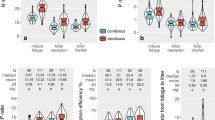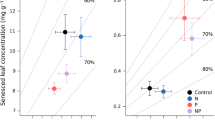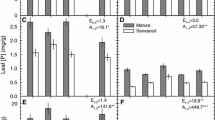Abstract
A descriptive temporal model is considered to be the best available estimator for accretion, resorption and proportional nutrient resorption. However, ecological studies rarely collect sufficient data for applying such a model. A less-demanding and commonly used estimator for proportional resorption (PR) calculates PR as the percentage of the nutrient pool that is withdrawn from mature foliage before leaf abscission. Data from an intensive sampling campaign of the aboveground nutrient pools and fluxes of two Betula pendula Roth. stands were used. We showed that the commonly used estimator is not an accurate estimator for accretion, resorption and proportional resorption. The commonly used estimator underestimated the proportional resorption of N on the average by 3–10%, and the proportional resorption of P by 20–25%. The low accuracy of the estimations was shown to be caused by a lack of selectiveness of the commonly used estimator. In other words, the commonly used estimator does not measure the underlying processes in specific nutrient accretion and resorption at the stand level. However, when a sufficiently high sampling density with several samples at a given point in time is used, then the commonly used estimator preserves the ranking relationship between the PR of different sites for N in 97% of the cases and for P in 71%. The commonly used estimator can thus be used in comparative studies as an index for proportional nutrient resorption only. The quantitative results should not be taken literally, as they are based on only two sets of observations. However, the results show that the commonly used estimator should no longer be used as a measure for accretion, resorption or PR whenever the plant accretes nutrients in the foliage as a compensation for nutrient losses due to foliar leaching and litterfall during the growing season.




Similar content being viewed by others
References
Aerts R (1996) Nutrient resorption from senescing leaves of perennials: are there general patterns? J Ecol 84:597–608
Aerts R, Chapin FS (2000) The mineral nutrition of wild plants revisited: a re-evaluation of processes and patterns. Adv Ecol Res 30:1–67
Ahti T, Hämet-Ahti L, Jalas J (1968) Vegetation zones and their sections in northwestern Europe. Ann Bot Fenn 5:169–211
Anderson HV, Hovmand MF (1999) Review of dry deposition measurements of ammonia and nitric acid to forest. Forest Ecol Manag. DOI 10.1016/S0378-1127(98)00378-8
Asner GP, Townsend AR, Riley WJ, Matson PA, Neff JC, Cleveland CC (2001) Physical and biogeochemical controls over terrestrial ecosystem responses to nitrogen deposition. Biogeochemistry. DOI 10.1023/A:1010653913530
Beier C (1991) Separation of gaseous and particulate dry deposition of sulfur at a forest edge in Denmark. J Environ Qual 20:460–466
Côté B, Fyles JW, Djalivand H (2002) Increasing N and P resorption efficiency and proficiency in northern deciduous hardwoods with decreasing foliar N and P concentrations. Ann For Sci. DOI 10.1051/forest:2002023
Chapin FS (1980) The mineral nutrition of wild plants. Annu Rev Ecol Syst 11:233–260
Chapin FS, Kedrowski RA (1983) Seasonal changes in nitrogen and phosphorus fractions and autumn retranslocation in evergreen and deciduous taiga trees. Ecology 64:376–391
Duchesne L, Ouimet R, Camiré C, Houle D (2001) Seasonal nutrient transfer by foliar resorption, leaching, and litterfall in a northern hardwood forest at Lake Clair Watershed, Qubec, Canada. Can J For Res 31:333–344
Eckstein RL, Karlsson PS, Weih M (1999) Leaf life span and nutrient resorption as determinants of plant nutrition conservation in temperate-artic regions. New Phytol. DOI 10.1046/j.1469–8137.1999.00429.x
Efron B, Tibshirani RJ (1993) An introduction to the bootstrap. Chapman & Hall, New York
Franklin O, Agren GI (2002) Leaf senescence and resorption as mechanisms of maximizing photosynthetic production during canopy development at N limitation. Funct Ecol 16:727–733
van Heerwaarden LM, Toet S, Aerts R (2003) Current measures of nutrient resorption efficiency lead to a substantial underestimation of real resorption efficiency: facts and solutions. Oikos 101:664–669
Helmisaari HS (1992) Nutrient retransloctaion within foliage of pinus sylvestris. Tree Physiol 10:45–58
Kellomäki S, Rouvinen I, Peltola H, Strandman H (2000) Density of foliage mass and area in the boreal forest cover in Finland, with applications to the estimation of monoterpene and isoprene emissions. Atmos Environ. DOI 10.1016/S1352-2310(00)00309-5
Kellomäki S, Rouvinen I, Peltola H, Strandman H, Steinbrecher R (2001) Impact of global warming on the tree species composition of boreal forests in Finland and effects on emissions of isoprenoids. Global Change Biol. DOI 10.1046/j.1365-2486.2001.00414.x
Kiikkilä O (2003) Heavy-metal pollution and remediation of forest soil around the Harjavalta Cu–Ni Smelter in SW Finland. Silva Fenn 37:399–415
Killingbeck KT (1985) Autumnal resorption and accretion of trace metals in gallery forest trees. Ecology 66:283–286
Killingbeck KT (1996) Nutrients in senesced leaves: keys to the search for potential resorption and resorption proficiency. Ecology 77:1716–1727
Killingbeck KT, May JD, Nyman S (1990) Foliar senescence in aspen (Populus tremuloides) clone: the response of element resorption to interramet variation and timing of abscission. Can J For Res 20:1156–1164
Knops JMH, Koenig WD, Nash III TH (1997) On the relationship between nutrient use efficiency and fertility in forest ecosystems. Oecologia 10:550–556. DOI 10.1007/s004420050194
Luyssaert S, Mertens J, Raitio H (2003) Support, shape and number of replicate samples for tree foliage analysis. J Environ Monit. DOI 10.1039/b210727a
May JD, Killingbeck KT (1992) Effects of preventing nutrient resorption on plant fitness and foliar nutrient dynamics. Ecology 73:1868–1878
Norby RJ, Cotrufo MF (1998) A question of litter quality. Nature. DOI 10.1038/23812
Norby RJ, Long TM, Hartz-Rubin JS, O’Neill EG (2000) Nitrogen resorption in senescing tree leaves in a warmer, CO2-enriched atmosphere. Plant Soil. DOI 10.1023/A:1004629231766
Nordell KO, Karlsson PS (1995) Resorption of nitrogen and dry-matter prior to leaf abscission—variation among individuals, sites and years in the Mountain Birch. Funct Ecol 9:326–333
Oland K (1963) Changes in the content of dry matter and major nutrient elements of apple foliage during senescence and abscission. Physiol Plantarum 16:682–694
Oleksyn J, Reich PB, Zytkowiak R, Karolewski P, Tjoelker MG (2003) Nutrient conservation increases with latitude of origin in European Pinus sylvestris populations. Oecologia. DOI 10.1007/s00442-003-1265-9
Saur E, Nambiar E, Fife D (2000) Foliar nutrient retranslocation in Eucalyptus globus. Tree Physiol 20:1105–1112
Staaf H (1982) Plant nutrient changes in beech leaves during senescence as influenced by site characteristics. Acta Oecol 3:161–170
Ulrich B (1983) Interaction of forest canopies with atmospheric constituents: SO2, alkali and earth alkali cations and chloride. In: Ulrich B, Pankrath J (eds) Effects of accumulation of air pollutants in forest ecosystems. Reidel, Dordrecht, pp 33–45
Wright IJ, Westoby M (2004) Nutrient concentration, resorption and lifespan: leaf traits of Australian sclerophyll species. Funct Ecol 17:10–19
Acknowledgements
Sebastiaan Luyssaert was funded by a Marie Curie Individual Fellowship (QLK-CT-2001–51941), Jeroen Staelens was funded as a Research Assistant of the Fund for Scientific Research (F.W.O.), Flanders, Belgium. The authors wish to thank Timo Salmi from the Finnish Meteorological Institute for providing unpublished deposition data. The laboratory and field staff, Ghislaine Dossou and Toni Tunturi are thanked for their help with many practical issues. The experiments comply with the current laws of Finland.
Author information
Authors and Affiliations
Corresponding author
Additional information
Communicated by Christian Koerner
Rights and permissions
About this article
Cite this article
Luyssaert, S., Staelens, J. & De Schrijver, A. Does the commonly used estimator of nutrient resorption in tree foliage actually measure what it claims to?. Oecologia 144, 177–186 (2005). https://doi.org/10.1007/s00442-005-0085-5
Received:
Accepted:
Published:
Issue Date:
DOI: https://doi.org/10.1007/s00442-005-0085-5




